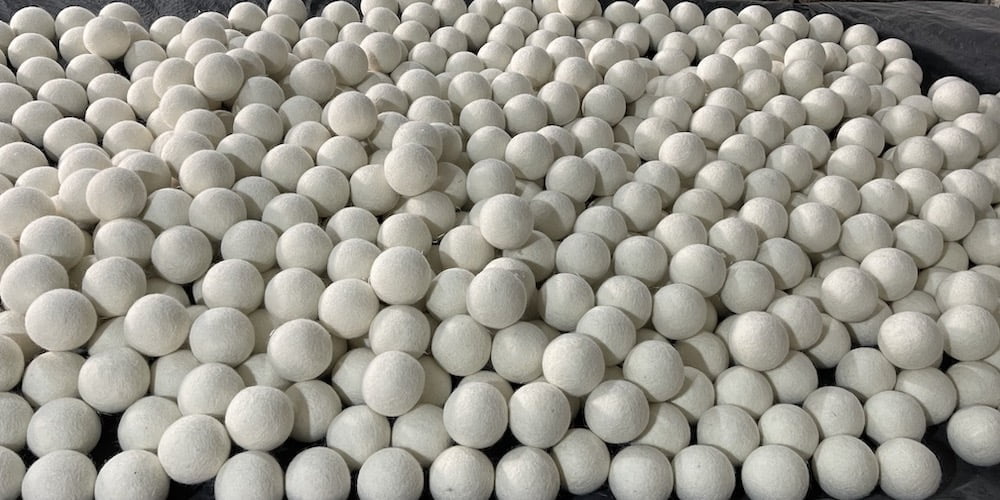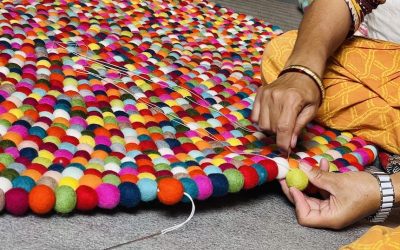Crafting Handmade Dryer Balls: Embracing the Traditional Felting Method
Making of Wool Dryer Balls in a Traditional felting Method
In today’s world, where sustainability and eco-consciousness are gaining importance, many individuals are turning to handmade products. One such item that has gained popularity is the handmade wool dryer balls. These small, felted balls not only reduce drying time and energy consumption but also offer a natural alternative to chemical-laden dryer sheets. In this blog post, we will explore the art of manufacturing handmade dryer balls through the traditional felting method. We will delve into the process, materials needed, benefits, and tips for using and caring for these eco-friendly laundry companions.

What is Traditional Felting?
Exploring History, Significance, and Craftsmanship Traditional felting is a centuries-old craft that involves transforming loose fibers, typically wool, into a solid and cohesive fabric through a combination of moisture, heat, and friction. This time-honored technique holds historical significance and cultural heritage in various regions around the world. Let’s delve into the intricacies of traditional felting, its historical roots, and the essential role of moisture, heat, and friction in the felting process. We’ll also explore the tools and materials required for this ancient craft.
A. Historical Significance and Cultural Heritage: Felting has a rich history dating back thousands of years. It is believed to be one of the oldest textile-making techniques known to humankind. The process of felting is closely associated with nomadic cultures, where felted fabrics were used for clothing, shelter, and daily necessities. From the yurts of Central Asia to the footwear of Indigenous peoples, felted items have played a vital role in providing comfort, insulation, and protection against the elements. Traditional felting techniques have been passed down through generations, preserving cultural heritage and craftsmanship in various parts of the Nepal.
B. The Role of Moisture, Heat, and Friction in the Felting Process: The felting process relies on three key elements: moisture, heat, and friction. Each plays a vital role in transforming loose fibers into a solid and durable fabric. Moisture: Moisture is essential to relax the natural scales present on wool fibers. When exposed to water, these scales open up, allowing the fibers to intertwine and bind together. The addition of soap or other alkaline substances helps break down the surface tension and facilitates the migration of fibers during the felting process. Heat: Heat is applied to expedite the felting process by encouraging the scales on the wool fibers to open further. It also helps to shrink and matt the fibers together, creating a denser and stronger fabric. Heat can be applied through various methods, such as hot water, steam, or the friction generated during the felting process.
Friction: Friction is the primary mechanism that causes the wool fibers to interlock and bind together. By rubbing, rolling, or agitating the fibers, the scales on the surface of the wool catch onto one another, creating a network of entangled fibers. This process, known as fulling, results in a solid and cohesive fabric.

Tools and Materials Required for Traditional Felting:
Wool Fibers: Wool is the most commonly used fiber for traditional felting. It possesses unique properties such as crimp, elasticity, and natural scales that enable it to interlock and mat together during the felting process. Different breeds of sheep offer varying wool characteristics, allowing for a diverse range of textures and finishes in the final felted fabric.
Water and Soap: Water is the primary medium used in the felting process. It helps the fibers become pliable and facilitates their migration and entanglement. Soap acts as a lubricant, reducing friction between the fibers and allowing them to slide and bind together more easily.
Agitation Tools: Various tools aid in the felting process. These include: Hands: The most basic and essential tool for felting, hands provide the necessary friction and pressure required to interlock the wool fibers.
Bubble Wrap: These surfaces provide a textured and slightly resistant base for rolling and agitating the fibers, aiding in the felting process. Rolling Sticks or Pool Noodles: These cylindrical objects are used to roll and compress the wool fibers, applying even pressure and facilitating the entanglement of the fibers. Felting Needles (optional)
Handmade dryer balls created through the traditional felting method offer a sustainable and effective solution for laundry drying which bring extra benefit to the users. By reducing drying time, softening fabrics, and eliminating the need for chemical-laden dryer sheets, these eco-friendly alternatives benefit both the environment and our well-being. Manufacturing dryer balls through the traditional felting process allows for customization, personalization, and the opportunity to support local artisans. By incorporating these handmade gems into our laundry routine, we can embrace sustainability, reduce energy consumption, and enjoy the many benefits of eco-conscious living.



